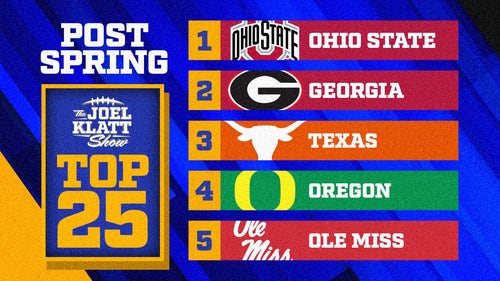
CFP expansion under discussion: What might that look like?
The university presidents who oversee the College Football Playoff are scheduled to meet Friday to discuss expanding the four-team format, re-opening the possibility that a new model for crowning a champion could be implemented as soon as the 2024 season.
Two people familiar with the situation told The Associated Press on Wednesday that CFP’s Board of Managers, led by Mississippi State President Mark Keenum, is set to convene by video conference.
There is no guarantee the presidents will take any official action or vote to approve an expansion model, but another person familiar with the situation told AP they would like to accelerate a process that had ground to a halt six months ago.
All the people spoke to the AP on condition of anonymity because the board’s plans were not being made public.
The CFP management committee, comprised of 10 FBS conference commissioners and Notre Dame’s athletic director, is scheduled to meet next week in Dallas.
The management committee is responsible for hashing out a format for the CFP, but the presidents have the final say on what happens with the playoff.
Back in February, CFP Executive Director Bill Hancock announced expansion talks among the commissioners had failed to produce the needed unanimous consensus in time for the format to change before the end of the current contract with ESPN. That deal runs through 2025.
The CFP recently announced the sites of the championship games for the final two seasons of the current 12-year deal.
Hancock said in February that expansion talks would resume later in the year with a focus on what the playoff would be starting in 2026.
Since then, the commissioners who opposed the proposed 12-team format have seemingly softened their stances. The commissioners left a June meeting with renewed optimism their differences could be worked out, one of the people said.
"There's momentum," a source with knowledge of the conversations told ESPN. "There's definitely momentum."
Last year, the relatively new commissioners of the Pac-12, Big Ten and Atlantic Coast Conference pushed back against an expanded playoff plan that was unveiled in the summer 2021.
The 12-team model, which included six conference champions and six at-large teams, had been worked on for more than two years by a group of four commissioners, including Greg Sankey of the Southeastern Conference.
Concerns about automatic access for certain conferences, how the Rose Bowl would fit into an expanded format and the health and safety of players competing in as many as 17 games were cited as reasons against the 12-team plan.
Failure to reach an agreement on expansion left Sankey and others frustrated. Expanding the playoff before the end of the current television deal has been estimated to be worth an additional $450 million in media rights to the conferences.
American Athletic Conference commissioner Mike Aresco told ESPN that his conference is open to the 12-team format that had been proposed, but said a 16-team playoff would be even better as it would give all 10 FBS conference champions automatic bids. That "would be ideal," he said.
"That would energize and really help college football become much healthier," Aresco said. "It would make championship game weekend enormous. We think a 16-team playoff is something we absolutely should consider, and if it included 10 automatic and six at-larges it would be great for college football."
How a 12-team format would work
— Six conference champions would receive automatic bids, with the other six teams earning at-large bids by virtue of their CFP ranking.
— The top four conference champions would receive byes. The others would be seeded 5-12, with seeds 5-8 earning on-campus home games.
— The quarterfinals would be played at bowl sites.
Last season it would have broken down like this:
Byes
1. Alabama (SEC champ)
2. Michigan (Big Ten champ)
3. Cincinnati (American Athletic champ)
4. Baylor (Big 12 champ)
Rest of the field
5. Georgia
6. Notre Dame
7. Ohio State
8. Ole Miss
9. Oklahoma State
10. Michigan State
11. Utah
12. Pitt
Matchups
No. 12 Pitt at No. 5 Georgia — winner vs. No. 4 Baylor
No. 11 Utah at No. 6 Notre Dame — winner vs. No. 3. Cincinnati
No. 10 Michigan State at No. 7 Ohio State — winner vs. No. 2. Michigan
No. 9 Oklahoma State at No. 8 Ole Miss winner vs. 1. Alabama
Of note, No. 13 BYU, which is an independent, would have been left out despite beating Pac-12 champ Utah.
How a 16-team format would work
No official 16-team plan has been proposed, but potentially the champion of each conference (American Athletic, ACC, Big Ten, Big 12, C-USA, Mid-American, Mountain West, Pac-12, SEC, Sun Belt) would receive automatic bids, with the remaining six at-large teams chosen by best CFP rankings.
The CFP rankings could also be used to seed the teams in a four-round tournament without byes.
Last season, the first-round matchups would have likely looked like this.
No. 1. Alabama (SEC champ) vs. No. 16 Northern Illinois (MAC champ)
No. 2. Michigan (Big Ten champ) vs. No. 15 UTSA (C-USA champ)
No. 3. Georgia (at-large) vs. No. 14 Utah State (Mountain West champ)
No. 4. Cincinnati (C-USA champ) vs. No. 13 Louisiana (Sun Belt champ)
No. 5. Notre Dame (at-large) vs. No. 12 Pitt (ACC champ)
No. 6. Ohio State (at-large) vs. No. 11 Utah (Pac-12 champ)
No. 7. Baylor (Big 12 champ) vs. No. 10 Michigan State (at-large)
No. 8. Ole Miss (at-large) vs. No. 9. Oklahoma State (at-large)
The Associated Press contributed to this story.













































































































































